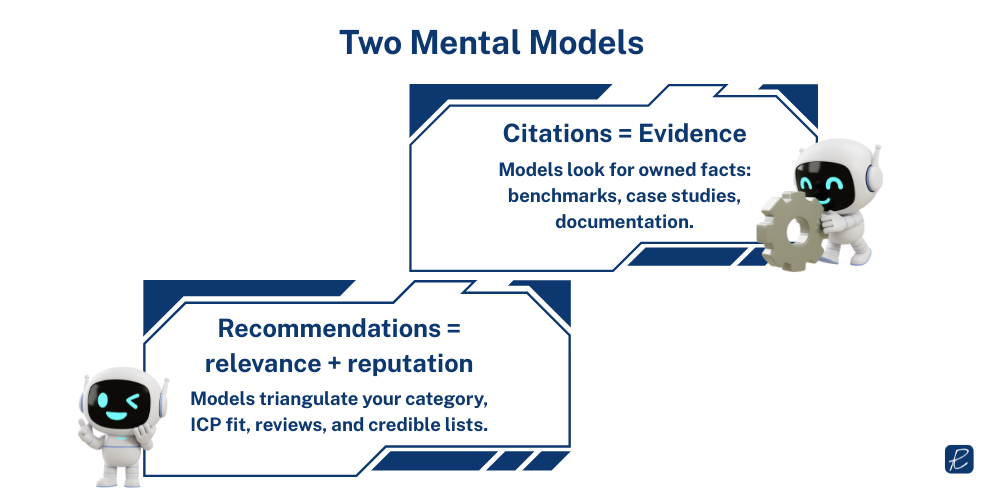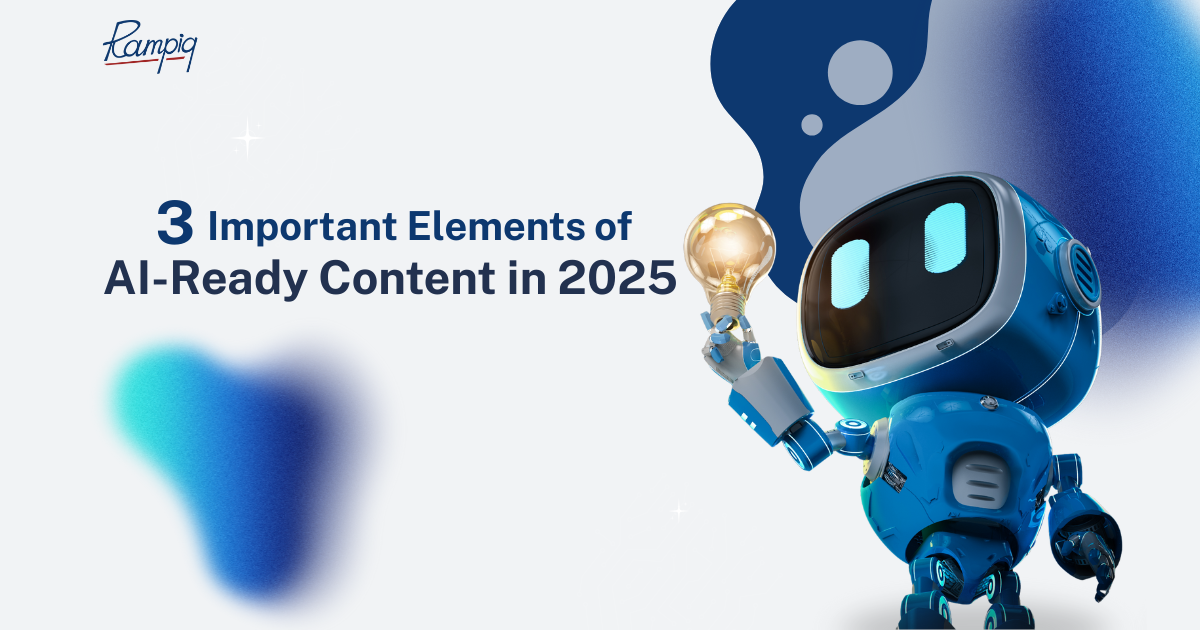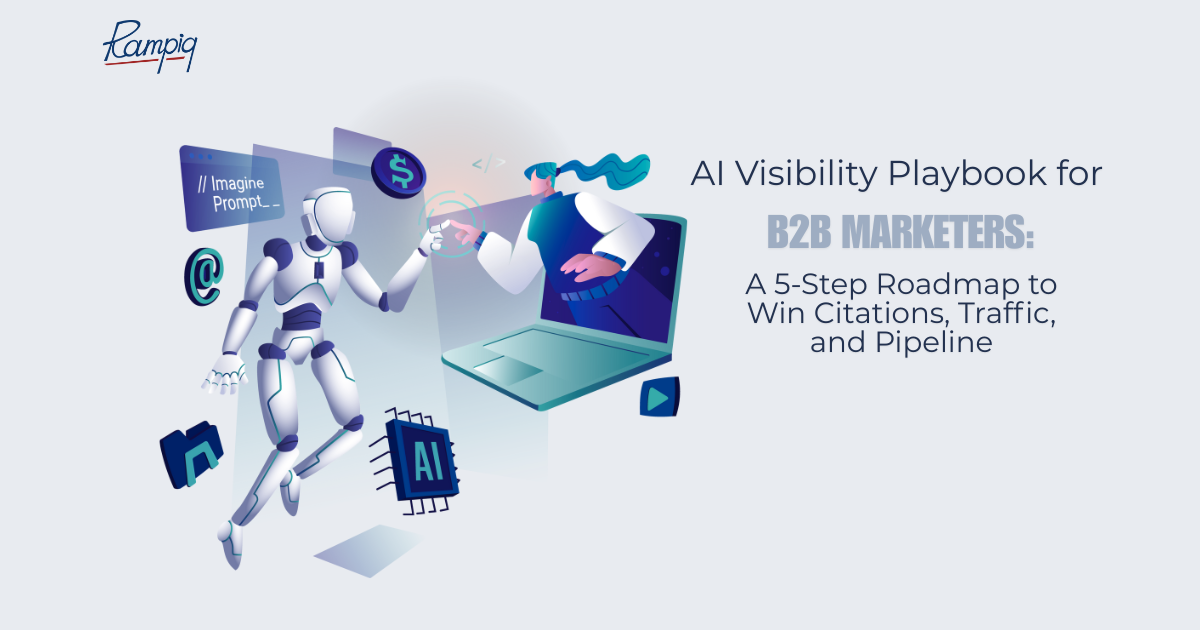AI Search Ranking Factors: What “Controllable” Really Means
The fastest wins come from signals you already influence: your positioning, your proof, and where your brand shows up.
When I say “AI search ranking factors,” I’m really talking about levers that increase your probability of being cited (quoted as a source) or recommended (named as a vendor). Citations build authority; recommendations build pipelines. Both matter, but if you’re picking one to prioritize this quarter, go after recommendations. That’s where deals start.
Two mental models I share with CMOs:

- Citations = evidence. Models look for owned facts: benchmarks, case studies, documentation.
- Recommendations = relevance + reputation. Models triangulate your category, ICP fit, reviews, and credible lists.
Frame your roadmap around those two, and the noise drops.
The list below is conversational by design. I’ll tell you why each factor matters, what to do this quarter, and how to check if it’s paying off.
Category Positioning & ICP Labeling
If you want AI to put you on the right shortlist, tell it – everywhere – exactly what you are and who you’re for.
I’ve watched recommendations flip with one qualifier: add “enterprise” to the prompt, and the list changes. That’s your cue. Use precise category language on your site and in third-party profiles and reviews: “Enterprise B2B marketing agency,” “MVP launch partner,” “Healthcare app development for payers,” whatever actually fits you. Then reinforce it in customer quotes and case study titles. Consistency is the game: site headlines, Clutch/G2, LinkedIn company description, partner directories, all singing the same song.
Do this now: audit your labels; standardize the phrasing; update the top five surfaces customers and models see first.
Presence in Credible Top Lists & Industry Directories
If buyers and analysts rely on a list, assume the model does too.
I’m not talking about spammy “submit your site” lists. I mean the credible roundups in your niche: Gartner/Market Guides, well-regarded trade publications, respected community curators. Yes, some won’t give links. Get the mention anyway. AI assistants frequently reflect these lists when assembling vendor recommendations. You can influence this with quarterly digital PR and thoughtful outreach. Pitch your proof, not your homepage.
Do this now: pick 10–15 credible lists per category, pitch with a one-pager of outcomes and named logos, and politely request inclusion.
First-Party Research Library (Benchmarks, Case Studies, PDFs)
Facts are sticky. First-party facts are stickiest. Models “hunt” for numbers and specifics. If your site houses real benchmarks, quantified case studies, and honest “how it works” write-ups, you’ll get cited more often, and that authority bleeds into recommendations later.
To educate LLMs about your brand, host assets on your domain (not only on a marketing platform), and make at least some of them accessible to crawlers. I like pairing an HTML landing page (for readability, internal links, and CTAs) with a well-formatted PDF (for portability and citations). Add a 100-word abstract that states the key number plainly.
Do this now: move priority PDFs on-domain, allow crawling in robots.txt, write TL;DR abstracts, and link them from relevant service pages.
Commercial-Intent Pages (Service × Industry / Use Case / Tech)
Own the landing page that buyers expect to exist. A common reason teams “vanish” from AI-assisted discovery? They publish piles of generic blogs but no specific landing pages.
Think in combinations: Service + Industry, Service + Use Case, Service + Technology. “SEO for PLG SaaS.” “Digital PR for cybersecurity.” “Healthcare mobile app development.” These pages match purchase intent, earn clicks after a summary, and give analysts/journalists a place to point. Build each page like a mini home page: outcome-first headline, proof, process snapshot, FAQ, and a sensible CTA.
Do this now: shortlist 8–12 high-value combinations and ship them before you write another TOFU post.
Documentation, Help Center & Product Content
If you’ve got product or implementation depth, show it. Docs are the quiet engine behind a lot of citations. They answer specific, technical questions cleanly, which models adore. Even for services firms, a “How we implement X” or “Architecture patterns for Y” library does the job.
Keep the tone clear, add named components and numbers, and link to related commercial pages. You’re giving AI an easy, credible block to quote, and buyers the reassurance that you’ve done this before.
Do this now: publish one pragmatic guide that answers a gnarly, recurring question your sales team gets and give it a crisp summary up top.
Review Velocity & Proof on Third-Party Platforms
Real, recent, specific reviews nudge recommendations in your favor. Ask for reviews in waves (quarterly works) and coach customers to be specific: industry, team size, problem, outcome.
If “enterprise” is your lane, don’t be shy about asking customers to use that word naturally. It’s not gaming; it’s clarity. Most platforms allow private “review prompts.” Use them to avoid generic fluff. Then showcase the freshest three on relevant pages with permission.
Do this now: run a two-week review drive with targeted prompts and a thank-you gesture that’s ethical and allowed by the platform.
Executive POV, Digital PR & Category Narrative
Your voice travels further than your blog. When your CEO (or practice lead) publishes opinionated, useful takes, and those takes appear in credible outlets or events, you show up in the places models and humans mine for authority.
Set a simple cadence: one meaningful POV piece per month, one analyst/influencer briefing per quarter, and two partner co-marketing actions per half. Tie the topics to your pillars so every new mention strengthens a theme you care about.
Do this now: pick one pillar that maps to revenue and book two activities against it this month: a byline pitch and a partner webinar.
Information Architecture & Internal Linking for Topical Authority
Fewer, stronger hubs beat hundreds of thin pages. Topical authority does not equate to stuffing your site with tangents, you should make it obvious where you’re world-class. I like 3–5 pillars with real depth, each anchored by a hub page and linked sub-pages (services, case studies, docs, research). Use internal links like signposts between closely related pages. Resist the urge to chase every long-tail. Authority spreads thinner than you think.
Do this now: pick your 3–5 pillars and sketch the hub → spoke structure on one slide. If a page doesn’t reinforce a pillar, rethink it.
File Accessibility & Robots for PDFs/Images
If AI can’t crawl your proof, it can’t cite it. You don’t need to ungate everything to feed AI. You do need to make some evidence crawlable and attributable to your brand.
That means: host key PDFs and images on your domain, allow them in robots.txt, and give them sensible filenames and titles. If you’re nervous about analytics, you can fire GA via a redirect or a click event before the file opens so you at least see engagement.
Do this now: add a short “AI-friendly” library: 3–5 on-domain PDFs you’re happy to be quoted on, each with an HTML abstract page.
On-Page Clarity & Quotability (Claims, Numbers, TL;DRs)
If a claim can’t be lifted in one line, it probably won’t be. Start major pages with the closest thing to the answer. Then state your key claim with a number and context: “Our PLG SEO playbook cut CAC payback by 27% for mid-market SaaS in 90 days.”
Attribute to a named customer where possible. Add a TL;DR box at the top with 2–4 bullets and a link to your source PDF or case study. You’re making life easy for busy humans and token-constrained models.
Do this now: add a TL;DR block and a single, quotable claim to your top five commercial pages.
Measuring AI Visibility
Measure movement where it happens: on the pages that actually sell. Rank trackers will lag and wobble. Instead, add three simple lenses to your dashboard:
- Top Viewed Pages: watch for pricing, demo, and service pages climbing even when they weren’t the initial landing page.
- Dark traffic triangulation: correlate direct traffic lifts with server log pings from known AI crawlers and branded query upticks in GSC.
- CRM tie-back: tag opportunities influenced by your new commercial pages or research assets. This is the number the ELT cares about.
Optional for the keen: explore appearance tracking tools or APIs that flag when your brand shows up in AI overviews. Not perfect, but directionally useful.
FAQs
Do we need to ungate all our assets?
No. Use a hybrid approach: ungate the pieces you’re proud to be quoted on (abstracts, executive summaries, a few full reports) and keep the rest behind a form if the economics make sense.
Do unlinked mentions in credible lists still help?
Yes. Assistants and analysts read the same lists your buyers do. A mention in the right place can move recommendations, even without a live link.
Will lots of commercial pages cause cannibalization?
If you clone content, yes. If each page targets a real Service × Industry/Use Case/Tech need with unique proof and FAQs, you’re building a strong semantic hub, not cannibalizing.
Are blogs “dead” in the AI era?
No, but the mix changes. Keep select, high-quality thought leadership that strengthens your pillars, and spend the bulk of your energy on commercial pages and first-party proof.
How do I track PDF engagement if GA4 doesn’t see files?
Fire a tracking event before the file loads (via GTM or a redirect) and watch navigation to money pages in your Top Viewed Pages report.
What’s the single fastest lever for a net-new pipeline via AI?
Tighten your category/ICP labels, secure inclusion in a handful of credible lists, and ship specific commercial pages. That combo moves recommendations quickly.







